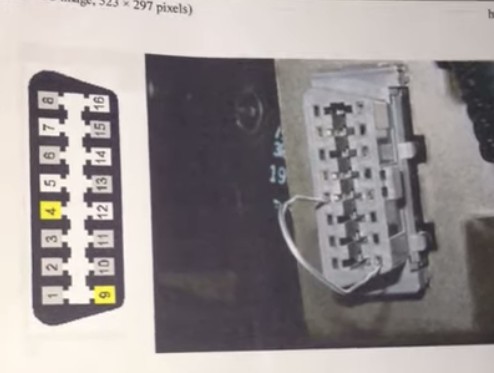It happens to the best of us. When trying to diagnose car issues by jumping the OBD2 port, a simple mistake can lead to unexpected electrical problems. This article explores what can occur if you accidentally short your OBD2 port, drawing from a real-life experience and providing troubleshooting steps.
One Honda Element owner encountered this exact scenario. Intending to jump pins 4 and 9 to read transmission codes, they mistakenly connected pins 5 and 16. Referring to standard OBD2 pinouts, this error effectively shorted pin 16, which carries +12V battery power, to pin 5, the signal ground.
 OBD2 Port Correct Jumper Location
OBD2 Port Correct Jumper Location
While the owner was eventually able to correctly jump pins 4 and 9 and retrieve a transmission code, they soon discovered several electrical accessories were no longer functioning. This highlights the potential consequences of incorrectly jumping pins on your OBD2 port.
Symptoms of a Shorted OBD2 Port
After the accidental short circuit, the Honda Element exhibited a range of electrical issues. Here’s a breakdown of what stopped working:
- Radio: No power.
- Dome Light: Only works when the key is in the ON position, not when doors are opened.
- Power Locks:
- Key ON: Unlock button works, lock button does not. Manually pushing the lock knob locks all doors.
- Key OFF: Lock buttons and manual knob have no effect.
- Remote Key Fob: No functions work.
- Cruise Control Button: The on/off button near the driver’s knee does not illuminate.
- OBD2 Port: Scanner no longer works; no voltage on pin #16 (12V power).
Interestingly, some systems continued to function normally, including:
- External lights (headlights, turn signals, brake lights, reverse lights)
- Rear hatch dome light
- 12V accessory socket in the passenger dash
- Power windows
- Power mirrors
This pattern suggests that the short circuit primarily affected circuits related to accessory power and interior convenience features, while critical vehicle functions remained operational.
Troubleshooting a Shorted OBD2 Port
If you’ve made a similar mistake and are experiencing electrical problems after attempting to jump your OBD2 port, here’s a troubleshooting approach:
-
Check Fuses: This should be your first step. Consult your vehicle’s owner’s manual for fuse box diagrams. Look for fuses related to:
- Radio/Infotainment
- Interior lights/Dome light
- Power door locks
- Accessory power/Cigarette lighter
- OBD2 port power
A blown fuse is the most likely cause of these issues after a short circuit. Replace any blown fuses with new ones of the correct amperage.
-
Inspect Wiring: If fuses are not the issue, a more serious wiring problem might exist. A short circuit can potentially damage wiring or components beyond just fuses. This is more complex and may require professional diagnosis.
-
Consider a Wiring Diagram: For deeper troubleshooting, a wiring diagram specific to your vehicle model is invaluable. This will help you trace the circuits affected by the short and identify potential damage points.
Why Does This Happen?
Shorting the +12V power (pin 16) to ground (pin 5) creates a direct path for high current flow. This overload can blow fuses designed to protect circuits. However, in some cases, the surge might damage other components if the fuse doesn’t blow quickly enough, or if the short affects circuits not directly protected by the immediately obvious fuses.
Preventing OBD2 Port Short Circuits
To avoid these problems in the future:
- Double-Check Pinouts: Always verify the correct OBD2 pinout diagram for your vehicle before jumping any pins.
- Use the Right Tools: If you’re unsure about manual jumping, consider using an OBD2 scanner or code reader that is designed for safe diagnostics.
- Work in Good Lighting: Ensure you can clearly see the pin numbers on the OBD2 port to avoid mistakes.
Conclusion
Accidentally shorting your OBD2 port can lead to frustrating electrical issues. However, in many cases, the problem is isolated to blown fuses. By systematically checking your fuses and understanding the potential symptoms, you can often resolve these issues. If problems persist after checking fuses, seeking professional automotive electrical diagnosis is recommended to prevent further damage and ensure proper repair.